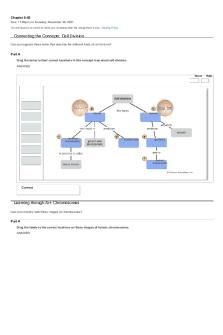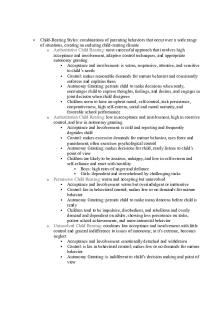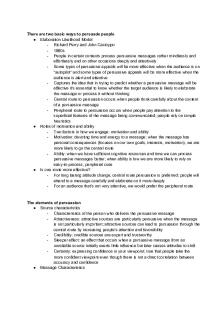Psychology Chapter 8 homework PDF

| Title | Psychology Chapter 8 homework |
|---|---|
| Author | Kayla Burr |
| Course | General Psychology |
| Institution | Howard Community College |
| Pages | 3 |
| File Size | 67.5 KB |
| File Type | |
| Total Downloads | 52 |
| Total Views | 143 |
Summary
Download Psychology Chapter 8 homework PDF
Description
Below are the questions you must answer for the Chapter 8 homework. All questions are worth 1 point except for the short answer. The homework must be done on a word processor. Your answers should be in your own words. Copying directly from the textbook without proper citation is plagiarism. 1. All of the following are examples of proactive interference EXCEPT : a. Dave recently changed his debit-card PIN, but still enters the old pin by mistake b. At the beginning of every semester, Dr. Amati calls her new students’ by the names of her students from the previous semester. c. James ruined his date with a new girlfriend by calling her is old girlfriend’s name d. Samantha lost her new combination lock she used at her gym. She has an old lock but can’t use it because she only remembers the combination numbers for the new lock. 2. If short-term memory can be thought of as what appears on the screen of your computer at any given moment, then long-term memory represents: a. The data stored in files for later retrieval b. The system of graphics processing c. The running of the central processing unit d. The information encoded in the screen image 3. If you believe that you have accurate episodic memories of events prior to your fourth birthday, you are probably basing your belief on: a. The emotional aspects of the experience b. The rehearsal of the event in short-term memory c. The existence of pictures/photographs of the event d. The encoding of specific details during your pre-school years 4. This retrieval process works when mood and other psychological states, including drug-induced changes in consciousness, act as retrieval cues: a. Elaborative rehearsal b. Method of loci c. Context-dependent memory d. State-dependent memory 5. a. b. c. d. 6. a. b.
When memory becomes conscious, it has been activated in this stage/store: Sensory memory Short-term memory Long-term memory Flashbulb memory This memory process involves making meaning out of our perceptions: Consolidation Storage
c. d.
Encoding Retrieval
7. The fact that information must be repeated – known as maintenance rehearsal- in order to remain in short-term memory is evidence that short-term storage is: a. Limitless b. Naïve c. Constrained d. Brief 8. This memory phenomenon is the reason that we can easily remember sentences composed of 20 words, but cannot remember 20 unrelated words in order: a. Expertise b. Phonological loop c. Memory span d. Chunking 9. The primary encoding processes effectively used in short-term memory (STM) and Long-term memory (LTM) are different. a. Name and describe the two main types of encoding used in STM. (4 pts) Acoustic encoding and visual encoding are the two main types of encoding used in STM. Acoustic encoding is when we encode memories by sound. Visual encoding is when we encode memories through imagery.
b.
Name and describe the most effective type of encoding used in LTM. (2 pts)
The most effective type of encoding used in LTM is semantic encoding. Semantic encoding is when we encode through meaning.
c. Why is the type of encoding used in LTM more effective than the types used in STM? (2pts) Semantic memory used in LTM is more effective because it creates longer’asting memories.
10. Your textbook discusses research on effective and ineffective tactics that students use when studying for an exam.
a. Name and describe 1 tactic discussed in your textbook that research shows is effective (helps) when studying for an exam (2 pts) Distributed practice is a tactic that is effective when studying for an exam. Distributed practice is short study sessions over time.
b. Name 2 tactics discussed in your textbook that research shows are ineffective (reduce exam performance) (2 pts) Two tactics that are ineffective are studying with distractions and sitting toward the back of the classroom....
Similar Free PDFs

Psychology Chapter 8 homework
- 3 Pages

Social psychology chapter 8
- 6 Pages

Psychology Chapter 8 Notes
- 6 Pages

Chapter 8 Homework
- 6 Pages

Chapter 8 Homework
- 39 Pages

Services homework chapter 8
- 2 Pages

Chapter 8 - Homework Hints
- 3 Pages

ACCT 2302 Chapter 8 Homework
- 3 Pages

Chapter 8-02 - Pearson - Homework
- 22 Pages
Popular Institutions
- Tinajero National High School - Annex
- Politeknik Caltex Riau
- Yokohama City University
- SGT University
- University of Al-Qadisiyah
- Divine Word College of Vigan
- Techniek College Rotterdam
- Universidade de Santiago
- Universiti Teknologi MARA Cawangan Johor Kampus Pasir Gudang
- Poltekkes Kemenkes Yogyakarta
- Baguio City National High School
- Colegio san marcos
- preparatoria uno
- Centro de Bachillerato Tecnológico Industrial y de Servicios No. 107
- Dalian Maritime University
- Quang Trung Secondary School
- Colegio Tecnológico en Informática
- Corporación Regional de Educación Superior
- Grupo CEDVA
- Dar Al Uloom University
- Centro de Estudios Preuniversitarios de la Universidad Nacional de Ingeniería
- 上智大学
- Aakash International School, Nuna Majara
- San Felipe Neri Catholic School
- Kang Chiao International School - New Taipei City
- Misamis Occidental National High School
- Institución Educativa Escuela Normal Juan Ladrilleros
- Kolehiyo ng Pantukan
- Batanes State College
- Instituto Continental
- Sekolah Menengah Kejuruan Kesehatan Kaltara (Tarakan)
- Colegio de La Inmaculada Concepcion - Cebu






